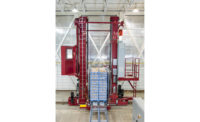The market for supply chain management software continues to grow, as supply chains become more complex and technologies become more sophisticated. Thankfully, today’s software solutions come equipped with better visibility, real-time capture, improved proof-of-delivery capabilities and cloud-computing technologies to help drive innovation and turn traditional supply chains into integrated value-added chains.
Cloud computing
Minneapolis-based HighJump Software created Profit Workbench, an activity-based costing solution for multi-tenant warehouse logistics professionals that handles profitability by customers/buildings and compares revenue against actual labor time, measuring overhead costs using a customer-driven allocation formula.
Other HighJump solutions include HJTMS transportation for 3PL professionals who own/manage their own fleet or freight program; Dynamic Workflow, which enables users to develop their own solutions for many aspects of the operation; True Commerce, an EDI network platform for logistics professionals; and Pulse, a supply chain intelligence solution aimed at increasing the availability and visibility of a business’ key performance indicators.
“Mobile and cloud-based computing continue to dominate the future of software,” says Joe Couto, chief operating officer. “The market is demanding a higher degree of order and inventory visibility. Manufacturers and processors are becoming more customer-centric. We are seeing different shelf-life needs by retailer, different pallet-height constraints by store, reduction in order shipping lead times, along with tighter inventory levels.”
Kewill Americas, on the other hand, initiated product updates to its MOVE on the Cloud software to offer faster deployments, flexibility in configuration, unparalleled scalability and resilience, says Walter Heil, vice president of multi-model transportation solutions for the Chelmsford, Mass., company.
Analytics at your fingertips
TARGIT BI, Cambridge, Mass., developed the TARGIT Decision Suite 2015, a self-service, cloud-based, business intelligence (BI) solution that is said to provide fast deployment and scalability.
“Logistics providers looking to keep costs down by tracking activities and gleaning insights/opportunities with data will find the robust data governance, ability to analyze both internal and external data, data visualization capabilities and comprehensive reporting on the cloud via Microsoft Azure to be transformative,” says Ulrik Pederson, chief technology officer.
In January, I.D. Systems, Woodcliff Lake, N.J., introduced PowerFleet IQ, which provides analytics on the utilization and safety of forklifts, order pickers, reach trucks and tow tractors. PowerFleet IQ provides visibility of fleet utilization, such as how many vehicles are in use simultaneously, what types of vehicles are in use, is the vehicle carrying a load or sitting idle and more, and issues a detailed report on high- and severe-impact incidents.
“Using the PowerFleet system’s idle operator reporting feature, supervisors can be automatically notified via the software’s notification feature when an operator’s vehicle is showing no movement for a pre-determined number of minutes inside the freezer, alerting the supervisor to potential health problems, vehicle failures or if the operator is sleeping in the heated-enclosed vehicle,” says Ken Ehrman, chief executive officer.
For its part, Omnitracs, LLC, Dallas, Texas, rolled out Roadnet Anywhere Tracking, a workforce tracking application that leverages a mobile app to provide fleet managers an “always-on” level of visibility into real-time locations.
“If a product ends up arriving late, or if the customer isn’t ready to receive it, the delivery could sit on a loading dock for hours before it’s addressed, and therefore elevating the risk of spoiled product,” says Kevin Haugh, general manager. “Omnitracs technology also accounts for key customer requirements, which enable customers to choose the timeframe they wish to receive their goods. If for some reason there is a deviation in the route due to an accident or bad weather, a notification system can provide an updated estimated time of arrival, allowing the customer to better anticipate load receipt and directing of their teams.”
In November 2015, International Business Systems (IBS), Roseville, Calif., released IBS Business Suite 2016, a synchronized software solution for distribution-intensive companies. Features include mobile offline sales order entry, enhanced yard management, multi-site/multi-building management and contract management inventory.
“With customers purchasing across multiple channels, including brick-and-mortar stores, online, over the phone, via mobile apps and direct from the warehouse, warehouse management systems must now be able to handle not only traditional, large pallet storage and shipping operations efficiently, but also embrace complex custom orders and services in the context of an omni-channel supply chain,” says Bill Tomasi, senior vice president product management.
In addition, Paragon Software Systems, Frisco, Texas, developed Paragon Route Control, where transportation planners can create routes that comply with time- and day-related local, state and national regulations and road closures due to construction zones or events such as the Boston Marathon.
“Creating rules that allow for legitimate deviations from the normal fastest route at specific times of the day, week or month by vehicle type reduces the level of manual intervention required by the transportation planner, and ensures that the schedule reflects what is actually happening on the roads,” says William Salter, president and CEO.
Paragon also created fleXipod, an electronic proof-of-delivery system that enables users to create, manage, deploy and utilize fully configurable data capture forms to change the driver “workflow.”
Electronic logging
GPS Insight, LLC, Scottsdale, Ariz., released ELD-2000, an electronic logging device that provides location tracking, hours of service (HOS) compliance, e-DVIR, speeding, idling, harsh acceleration/deceleration events and more.
Features include in-cab software, a color touchscreen application for driver login capabilities, roadside inspections, GPS fleet tracking, real-time electronic driver logs, driver vehicle inspection reports, a paperless FMCSA-compliant system and an HOS alert, which notifies recipients via text or email of pending HOS violations, according to John Gaither, commercial sales manager, East region, and ELD specialist.
Whether it be software that provides better visibility, tracking, real-time capture or proof-of-delivery capabilities, new cloud computing technologies help cold food processors and distributors manage today’s complex supply chains.










